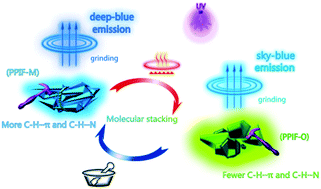Polymorphic mechanoresponsive luminescent material based on a fluorene–phenanthroimidazole hybrid by modulation of intramolecular conformation and intermolecular interaction†
Abstract
We present a new mechanoresponsive luminescent (MRL) material 2-(4-(9H-fluoren-2-yl)-1-phenyl-1H-phenanthro[9,10-d]imidazole (PPIF), displaying polymorphism and tunable emission colors via different external stimuli. Two types of PPIF single crystals, sky-blue crystal PPIF-M and green crystal PPIF-O, were obtained under different crystallization conditions. PPIF-M and PPIF-O show high-contrast MRL properties (with a grinding-induced spectral blue-shift of 61 and 84 nm, respectively). Interestingly, PPIF-M can be converted to PPIF-O upon in situ heating. It is found that the molecular conformation change plays an important role in the MRL behavior. Single crystal analyses, photophysical studies and theoretical calculations reveal that different molecular coplanarities result in different emission properties of PPIF-M and PPIF-O. Furthermore, the powder X-ray diffraction studies suggest that a phase transition between a crystalline state and an amorphous state is associated with the MRL properties. This study may provide an efficient strategy for tuning the MRL emission of polymorphic compounds.



 Please wait while we load your content...
Please wait while we load your content...